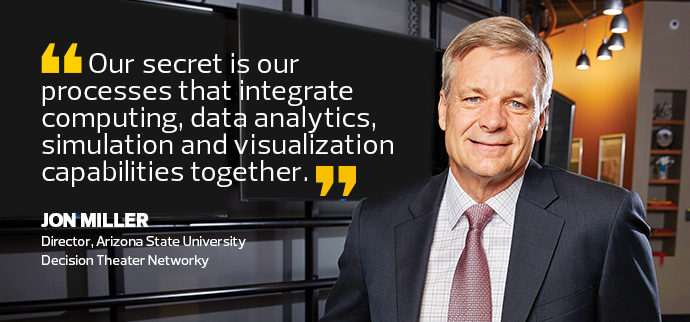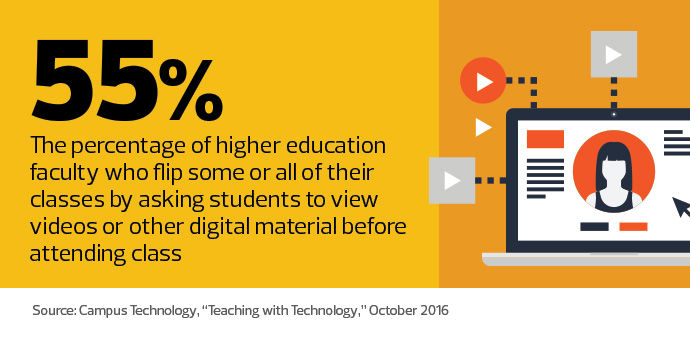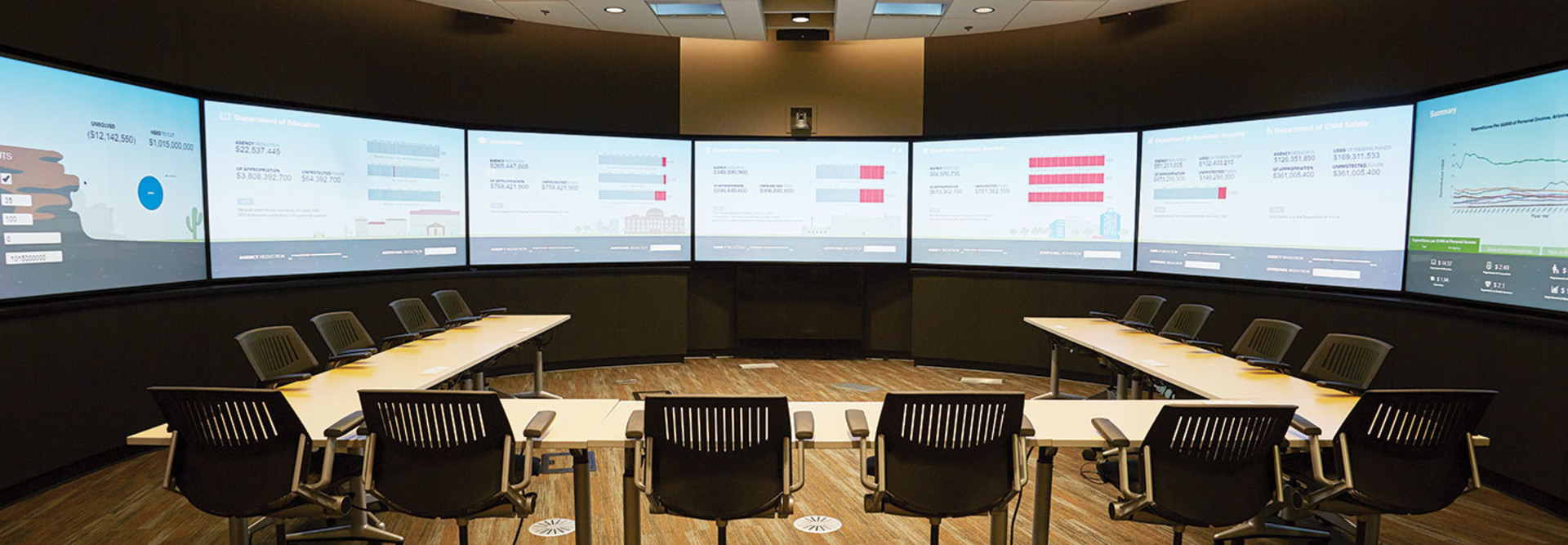On Campus, Video Applications of All Sizes Make Learning More Immersive
As decision-makers look for new ways to take advantage of the data-rich environment of higher education, some of them have zeroed in on an application both powerful and practical: using information to solve problems.
“The idea is that Big Data and technology should lead to better decision-making,” says Benjamin Freakley, executive director of the Decision Theater Network at Arizona State University.
The Decision Theater (DT) is an immersive visual environment with powerful computing capabilities that let researchers, policy makers and students see problems — and potential solutions — in new ways. Users leverage this innovative space to bring advanced data visualization and sophisticated analytics to bear on policy decisions.
“We have the tools to visualize complex problems and build models of all the permutations of solutions scenarios,” says Freakley. “The visually stimulating environment increases collaboration. People see what the data indicates and are more willing to move off of anchored positions.”
In Search of Adaptive Solutions
Several technology-rich spaces comprise the DT, but its heart is the so-called drum. There, participants are surrounded on three sides by seven Samsung 4G panoramic QFHD displays. High-performance computers by Dell and other manufacturers power specialized geographic information systems, 3D spatial visualization, and Tableau software for rapid data visualization. Offsite participants can join in via a Cisco Systems telepresence solution and Vimeo videoconferencing software.
Teams use a variety of software applications, along with specialized modeling algorithms developed for the DT. The Complex Systems Framework, a high-level computing environment that was developed in-house, orchestrates the integration of disparate models and supports interactive input/output on multiple screens and various devices.
“There is no silver bullet to solve complex problems, so there isn’t a particular tool set that we use,” says Jon Miller, director of the DT. “Our secret is our processes that integrate computing, data analytics, modeling, simulation and visualization capabilities together to create better understanding and, ultimately, collaborative problem solving.”
The DT’s resources attract outside organizations, but it also has significant value for the university community, Miller says. The facility is an asset and differentiator for researchers, both in their work and in pursuing grants. Faculty hold classes in the DT to help students explore decision-making skills. And administrators have convened in the DT to take advantage of its robust social media analysis capabilities, seeking to understand and improve the performance of university services.
“It’s a very agile and adaptive space for decision-making and as a teaching platform,” says Freakley. “We have the ability to take a deep look at individual problems, but also to build reusable models for finding solutions.”

Tech that Goes from Collaboration to Classroom
That same leap — from analyzing problems to crafting solutions — was also part of the mission when Portland State University in Oregon built its visualization theater last summer. Although inspired by ASU’s Decision Theater, PSU’s facility is now evolving into a slightly different model, says Douglas McCartney, director of Instructional Technology Services.
PSU’s team originally envisioned the theater as a space for university researchers and collaborators with outside organizations. Yet it has proved to be a rich teaching and learning environment as well — so much so that PSU renamed it the Virtualization Classroom.
Three 85-inch InFocus Mondopads dominate one side of the space. These devices — housing computing, videoconferencing and interactive whiteboard capabilities in a 4K touch-screen display — can show single or multiple images. Four 70-inch Mondopads are positioned on the other three walls of the room, supporting small-group collaboration.
“It is certainly a unique space for clients of the university, but more and more, as faculty explore its possibilities, it’s becoming an active learning classroom for any class that can benefit from collaboration, data visualization and video content,” McCartney says.
He predicts that PSU will build additional visualization spaces. “The concept works today and we want to do more of it tomorrow,” he says.
Video Tools Are a Shortcut to Student Engagement
Although these large-scale, immersive environments are impressive, the use of video on a much smaller scale is also worth paying attention to, says Malcolm Brown, director of the EDUCAUSE Learning Initiative.
“The cost of making and distributing video content has decreased, and there’s no longer a need for advanced technical skills,” Brown says. “It’s become much easier for faculty to give their students ‘anytime’ access to content.”
Anyone with a cellphone can make a video, and editing and mixing tools are almost as accessible, says Brown. Increasingly, instructors are presenting videos alongside other content, integrating all of this material into learning management systems.
Flipped Model Drives Discussion
Professor Michael Garver of Central Michigan University has been using video as a teaching tool for more than 10 years. He started by flipping his marketing classes: creating videos of lectures that students viewed before coming to class, where they then served as a basis for discussions.
“Using the videos makes a higher order of learning possible during class time,” says Garver. “It’s the difference between covering the material and ‘uncovering’ the material. It gives me a chance to help students learn to critique and make decisions about the content.”
More recently, Garver moved to TechSmith’s Camtasia for Mac to make his videos, which he distributes on a YouTube channel. The video editing software is designed to improve production values with a user-friendly interface that makes it easy to add music and graphics.
To Garver, video provides the creativity and flexibility to present materials in ways that get students engaged.

“My aim is to get their attention and hold their attention, rather than just being a talking head,” he says.
Garver’s students now make their final presentations on video, with the best ones serving as models for future classes. The anytime, anywhere accessibility of videos also makes them convenient for students who want to prep for exams or review difficult topics. As an additional benefit, the videos are a lasting resource.
“I’ve had students who took my class three years ago call and ask how they can get to the video playlist to refresh themselves,” says Garver. “The video advantage is both immediate impact and lasting value.”








